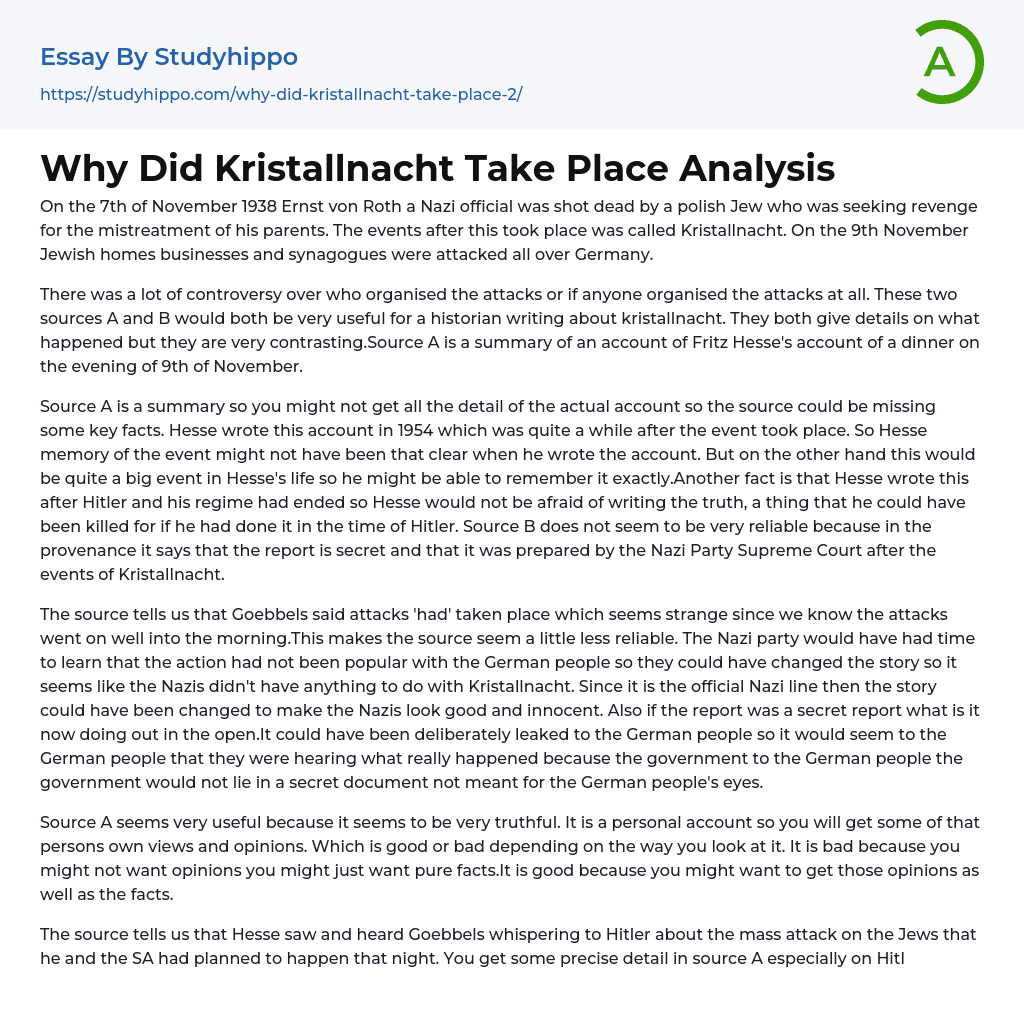Ernst von Roth, a Nazi official, was killed on November 7, 1938 by a Polish Jew seeking revenge for his parents' mistreatment. The resulting events were referred to as Kristallnacht. On November 9, Jewish homes, businesses and synagogues across Germany were assaulted.
Controversy surrounds the organization of the attacks during kristallnacht, with questions arising about whether anyone was responsible. Two sources, A and B, are valuable for historians studying this event, as they provide contrasting details on what occurred. Source A consists of a summary of Fritz Hesse's account of a dinner held on the evening of November 9th.
The summary provided in Source A may not include all the details of the actual account, possibly missing some essential facts. The account was written by Hesse in 1954, a significant time after the event occurred, which could result i
...n Hesse's memory being unclear. However, given the event's importance, Hesse might remember it precisely. An additional fact to consider is that Hesse wrote the account after Hitler's regime had ended, allowing him to write truthfully without fear of being killed, which may have been a risk had he done so while Hitler was in power. Source B's reliability is questionable as its provenance states that the report is confidential and prepared by the Nazi Party Supreme Court following Kristallnacht.
As per the source, Goebbels stated that attacks had taken place despite them continuing until morning. This raises doubts about the credibility of the source. The Nazi party had enough time to realize that their actions were not well-received by Germans and could have distorted their version to distance themselves from Kristallnacht. Since this is the official Nazi stance, it'
possible that they twisted facts to portray innocence. Additionally, if the report was confidential, it's unclear why it is now public. Perhaps it was intentionally leaked to create an impression that Germans were being informed truthfully about events as they unfolded; a secret document solely meant for German government officials would make lying difficult.
Source A appears to be reliable as it provides a personal perspective, including the author's views and opinions. This may be viewed positively or negatively depending on the reader's preferences. While some may prefer only factual information, others may appreciate the additional insights provided by the author's opinions.
According to the source, Hesse witnessed Goebbels and Hitler discussing the planned attack on Jews by the SA that night. The reliability of the source is strengthened by specific details provided in Source A, which describes Hitler's excitement at hearing of the plan. This information would be valuable to historians if the source is deemed trustworthy. It is speculated that Goebbels devised the plan to regain favor with Hitler, as he was currently experiencing a decline in status due to an extramarital affair with a Czech actress.
According to Hitler, there were inferior races. Source B supports the idea that Kristallnacht was premeditated by Goebbels and the SA. The source places responsibility for the violence against Jews on the German people, describing it as a sudden occurrence. Additionally, the source confirms that while the Nazis did not plan the attacks, they would not intervene if they began. The credibility of the source increases when Goebbels presents factual information from the night of the attacks, portraying the Nazis as innocent planners.
A historian would find
the factual information valuable in identifying the extent of the damage caused. Additionally, it helps to establish the official Nazi stance, which denied any involvement in initiating or containing the riots. However, despite a few points of similarity, the sources reveal significant differences. One commonality is that both sources agree on the time and location of the attacks, which occurred during a dinner.
According to both sources, Goebbels and Hitler were present. They also reported planned or carried out attacks on synagogues and Jewish businesses. The timeline of the sources differ, with Source A occurring before the attacks and Source B following them. Another point of similarity is Hitler's agreement with Goebbels' recommendations, despite the latter's disfavour. Additionally, both sources indicate Hitler's positive sentiment towards the acts of aggression against Jewish individuals.
For historians, having two conflicting sources stating the same information makes it more likely to be true. In regards to the attack on Jews during Kristallnacht, source A indicates that Goebbels and the SA arranged the attacks while source B claims it was a spontaneous event. The historian can use both sources as their agreement strengthens the validity of the information presented. However, source A is deemed more useful as it appears more credible and trustworthy.
According to the content, source A is deemed more useful as it provides additional details and factual information.
- Adolf Hitler essays
- Concentration Camps essays
- Elie Wiesel essays
- Holocaust essays
- Nazi Party essays
- Weimar Republic essays
- Adaptation essays
- Adventure essays
- Adversity essays
- Aging essays
- Alcohol essays
- Barbie Doll essays
- Beauty essays
- Care essays
- Carpe diem essays
- Change essays
- Chess essays
- Chicken essays
- Choices essays
- Contrast essays
- Crops essays
- Development essays
- Dream essays
- Evil essays
- Experience essays
- Family essays
- Farm essays
- Fire essays
- First Love essays
- Focus essays
- Greed essays
- Hero essays
- Holiday essays
- House essays
- Housing essays
- Humility essays
- Humor essays
- Hypocrisy essays
- Integrity essays
- Law of Life essays
- Life Changing Experience essays
- Life Experience essays
- Lifestyle essays
- Limitations essays
- Love Story essays
- Mother Tongue essays
- Motherhood essays
- My Neighborhood essays
- Myself essays
- Mystery essays




